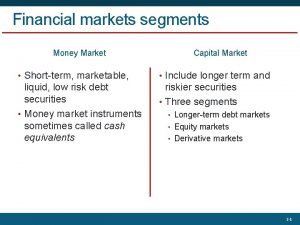CHAPTER 8 Identifying Market Segments Targets LEVELS OF
















- Slides: 16

CHAPTER 8 Identifying Market Segments & Targets

LEVELS OF MARKET SEGMENTATION

Mass Marketing In mass marketing, the seller engages in the mass production, mass distribution and mass promotion of one product for all buyers.

Segment Marketing In segment marketing, a firm decides to target several market segments and design separate offers for each. Benefits of segment marketing over mass marketing – ¨ It can better design, price, disclose and deliver the product/service to satisfy the target markets. ¨ It can fine-tune the marketing program and activities to better reflect competitors’ marketing.

Basic market-preference patterns Sweetness Clustered preferences Creaminess Diffused preferences Creaminess Homogeneous preferences Sweetness

Niche Marketing In niche marketing, a firm goes after a large share of one or a few submarkets with distinctive traits that may seek a distinctive mix of benefits. Characteristics of niches – ¨ They are fairly small ¨ They normally attract only one or two competitors ¨ They will pay a premium to the firm that best satisfies their needs

Local Marketing In local marketing, a firm tailors its products and marketing programs to suit the tastes of specific locations or local customer groups. ¨ Trading areas, neighborhoods, individual stores The experiential marketing promotes a product not just by communicating its features & benefits, but by also connecting it with unique and interesting experiences.

Customization / Customerization A company is customerized when it is able to respond to individual customers by customizing its product, services and messages on a one-toone basis. (Choiceboard)

Problems with customization: n Difficult to implement for complex products n Raise the cost of goods by more than the customer is willing to pay n Customers do not know what they want until they see actual product n Customers cannot cancel the order after the company has started to work on the product.

SEGMENTING MARKETS

Segmenting Consumer Markets Geographic segmentation Region, Density, Climate

Segmenting Business Markets Demographic Industry, company size, location Operating variables Technology, user status, customer capabilities Purchasing approaches Purchasing-function, power structure, nature of existing relationships, purchase policies and criteria Situational factors Urgency, application, size of order Personal characteristics Buyer-seller similarity, attitudes toward risks, loyalty

MARKET TARGETING

Effective Segmentation Criteria 1. Measurable Size, purchasing power, characteristics 2. Substantial Large and profitable segments 3. Accessible Reachable 4. Differentiable Distinguishable and respond differently to different marketing mix elements 5. Actionable Effective programs can be formulated for attracting and serving the segments

Evaluating & Selecting the Market Segments Two factors for evaluating different market segments– ¨ The segment’s overall attractiveness (Size, growth, profitability, low risk) ¨ The company’s objectives, competencies and resources

Selecting the market segments Single-segment concentration Selective specialization Product specialization M 1 M 2 M 3 P 1 P 1 P 2 P 2 P 3 P 3 Market specialization Full-market coverage M 1 M 2 M 3 P 1 P 2 P 3
 Identifying market segments and targets chapter 9
Identifying market segments and targets chapter 9 Identifying market segments and targets chapter 9
Identifying market segments and targets chapter 9 Identifying market segments and targets chapter 9
Identifying market segments and targets chapter 9 Five patterns of target market selection
Five patterns of target market selection Identifying market segments and targets
Identifying market segments and targets Identifying market segments and targets
Identifying market segments and targets The nfl targets several different market segments
The nfl targets several different market segments Identifying and non identifying adjective clauses
Identifying and non identifying adjective clauses Non identifying adjective clauses examples
Non identifying adjective clauses examples Identifying and non identifying adjective clauses
Identifying and non identifying adjective clauses Leader challenger
Leader challenger Targeting segmentation positioning
Targeting segmentation positioning Money market segments
Money market segments Customer segmentation & targeting
Customer segmentation & targeting Attractive market segments
Attractive market segments Magic wall interactive surfaces market segments
Magic wall interactive surfaces market segments Common market segments
Common market segments




























